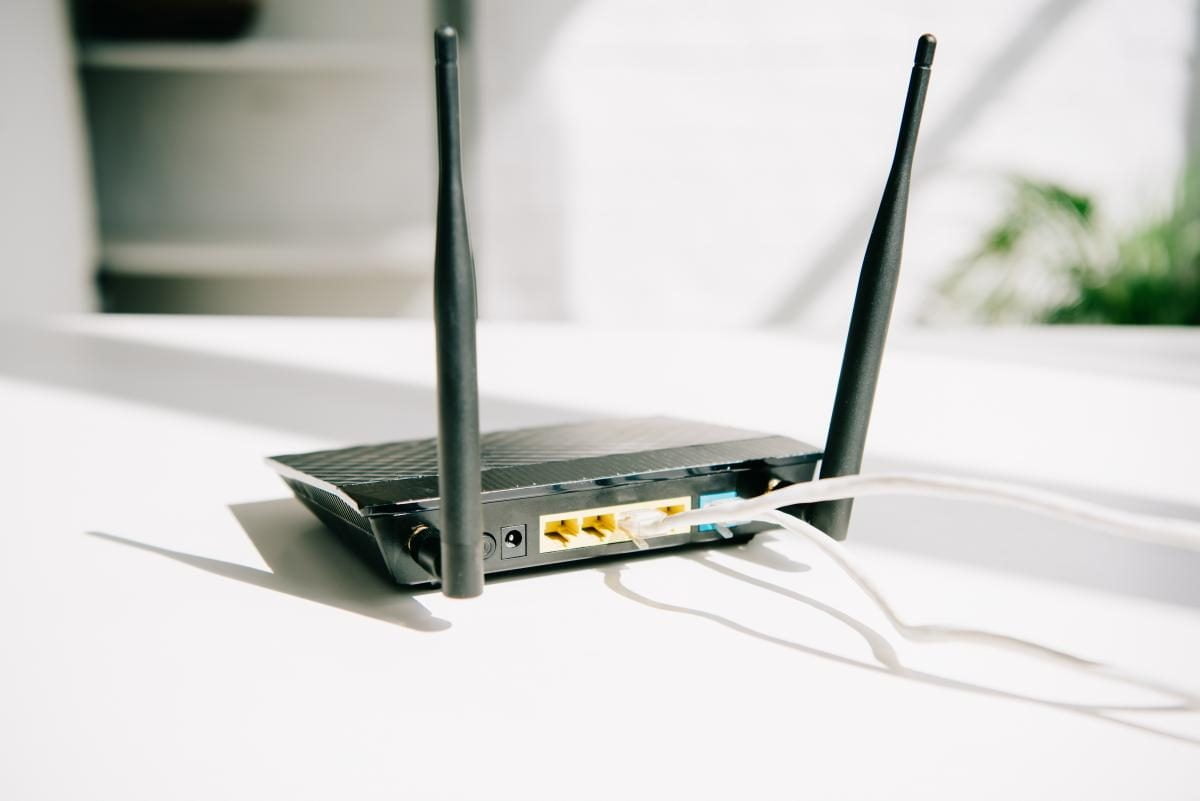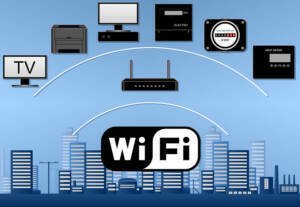- Optimizing router settings
- Setting the frequency range
- Changing your network name and password
- Updating hardware and drivers
- Check for device updates
- Installing new drivers on your computer
- Connecting a signal amplifier
- Choosing the optimal location for the amplifier
- Removing Interference
- Checking for Interference Sources
- Using Cable Shielding
- Using special programs
- Programs for signal amplification
- Programs for optimizing network settings
Optimizing router settings
A router is a device that allows you to connect several devices to the Internet at the same time. However, in order for Wi-Fi to work quickly and stably, you need to configure your router correctly. In this article, we will share 5 simple ways to improve your Wi-Fi.1. Updating Router FirmwareA router's firmware is the software that controls its operation. Firmware updates can improve Wi-Fi performance, fix bugs, and improve security. Typically, a firmware update can be downloaded from the manufacturer's website.2. Changing your Wi-Fi name and password Changing your Wi-Fi name and password can improve the security of your network and prevent unauthorized access to your data. Additionally, changing your name and password can improve Wi-Fi speed as it will help avoid conflicts with other networks.3. Changing Wi-Fi channel Wi-Fi signal interference can cause slower speeds and network instability. Changing the Wi-Fi channel may help resolve this issue. To do this, you need to select the least loaded channel.4. Enabling Quality of Service (QoS) Quality of Service (QoS) allows you to prioritize traffic on your network. This can help improve Wi-Fi speed and stability if you have multiple devices on your network that are using the Internet at the same time.5. Installing a Wi-Fi Repeater or Booster If Wi-Fi is not working well due to the long distance between the router and the device, you can install a Wi-Fi repeater or booster. The repeater repeats the Wi-Fi signal, the amplifier amplifies it. This will help improve the quality and speed of Wi-Fi in hard-to-reach places. By following these simple tips, you can improve Wi-Fi performance and enjoy fast and stable Internet.
Setting the frequency range
As you know, Wi-Fi operates on two frequency ranges - 2.4 GHz and 5 GHz. But not everyone knows that adjusting the frequency range can significantly improve the quality and speed of Wi-Fi.
If your router supports both bands, it is recommended to use 5 GHz for data transmission, as it provides higher speed and signal stability.
To configure the frequency range, you need to go to the Wi-Fi settings on your device and select the desired frequency. If you're not sure what frequency is being used, you can use special Wi-Fi signal testing apps that will show you what band your router is operating on.
But it is worth considering that using 5 GHz may have limitations in signal transmission range, so if you have a large house or apartment, then it may be better to use 2.4 GHz for a more stable signal in all rooms.
Either way, adjusting your frequency range is a simple and effective way to improve the quality and speed of Wi-Fi on your home network.
Changing your network name and password
If you want to improve the security of your Wi-Fi network, one of the first steps you should take is to change your network name and password. By default, most routers have a very simple username and password, which makes your network vulnerable to hacker attacks.
To change the network name and password, you need to go to the router settings. Depending on the router model, this process may differ slightly, but basically you should go to the router settings page in your browser and enter the administrator username and password. After this, you can change the network name and password to more complex and secure ones.
For example, you can use a combination of uppercase and lowercase letters, numbers, and special characters for your password. It's also a good idea to change the network name to something more unique to make it more difficult for attackers to identify your network.
Changing your network name and password is a simple but important step that can help improve the security of your Wi-Fi network.
Updating hardware and drivers
One of the easiest ways to improve Wi-Fi is to update your hardware and drivers. If your router or Wi-Fi adapter is outdated, your network speed and stability may be significantly reduced.
Before purchasing new hardware, make sure you are using the latest drivers for your Wi-Fi adapter. This can improve the stability and speed of your network.
If your router is outdated, consider purchasing a new one. New routers come with more advanced features, such as Wi-Fi 6 support, to improve the speed and stability of your network.
Also remember that the frequency of your Wi-Fi can affect the quality of the signal. If you are using the 2.4 GHz frequency, your network speed may be slower than using the 5 GHz frequency. If your router supports dual frequencies, consider switching to the 5GHz frequency to improve the speed and stability of your network.
Overall, updating your hardware and drivers is one of the easiest ways to improve the Wi-Fi in your home or office. Consider purchasing a new router and updating your Wi-Fi adapter drivers to improve the speed and stability of your network.
Check for device updates
One of the main factors affecting the quality of Wi-Fi performance is updating the device. Therefore, it is important to regularly check for available updates and install them.
To check for updates on a device with the Android operating system, you need to go to the settings, select 'About phone' or 'About tablet', then 'Software updates' and click on the 'Check for updates availability' button. If an update is available, you can install it.
Apple device owners need to go to Settings, select 'General', then 'Software Update'. If updates are available, you can install them.
Checking for updates can improve your device's performance, and following simple rules will help improve your Wi-Fi quality.
Installing new drivers on your computer
Drivers are software components that allow the operating system to communicate with your computer's hardware. Updating them can improve the performance of various components, including Wi-Fi adapters.
1. Find the model of your Wi-Fi adapter. This can be done by opening Device Manager (press Win + X keys and select this option), then find the Network Adapters section and find out which adapter you have installed.
2. Go to the website of the manufacturer of your Wi-Fi adapter and find the “Support” or “Drivers” section. There you will find the latest driver for your model.
3. Download and install the driver. This is usually done through an installer that automatically updates the driver. If the installer does not start automatically, find the downloaded file and run it.
4. Restart your computer. This is necessary for the changes to take effect.
5. Check if Wi-Fi is working better. If everything went well, you will notice an improvement in the speed and quality of your connection.
Updating drivers is a very important process that helps keep your hardware in good condition. Follow these simple steps and you will see how the Wi-Fi performance on your computer will improve.
Connecting a signal amplifier
One of the simple ways to improve Wi-Fi in your home is to use a signal booster. The device allows you to strengthen the router signal and expand the Wi-Fi coverage area.
To connect a signal amplifier you need to follow a few simple steps. First of all, you need to choose a suitable signal amplifier model that matches the characteristics of your router.
After this, plug the amplifier into a power outlet and configure it. To do this, connect the device to your computer and make settings through the web interface.
It is important to remember that the right place to install a signal booster is where the signal from the router is weakest. After installing the device and configuring its parameters, you can enjoy an improved Wi-Fi signal throughout your home.
Using a signal booster is a simple and affordable way to improve Wi-Fi in your home. It will help you avoid internet connection problems and improve the quality of your home network.
Choosing the optimal location for the amplifier
One of the main ways to improve Wi-Fi is to install a signal booster. However, choosing the optimal location for its installation plays a big role in the effectiveness of the device.
The first rule is to install the amplifier closer to the place where Wi-Fi is used most often. If it is a living room, then the device should be installed in this room.
The second rule is that the device must be located at a distance from the router to receive a quality signal. If the router signal is too weak, then installing an amplifier will not have any effect.
The third rule is that the device should not be hidden behind a wall, furniture or other obstacles. The fewer obstacles between the device and the devices that need to be connected to Wi-Fi, the better the signal quality will be.
Choosing the best location for the booster is an important step in improving Wi-Fi. Following simple rules, you can get maximum efficiency from the device. If you want to improve the quality of the Wi-Fi signal in your home or office, one way to do this is to connect the booster to the router. This will increase the range of the Wi-Fi network and strengthen the signal in hard-to-reach places.
To connect the amplifier to your router, you will need an Ethernet cable and access to the router settings. First, connect the amplifier to a power outlet and an Ethernet cable, then connect it to your router. Go to the router settings and select the 'Connecting devices' option. Click the 'Add' button and select 'Wi-Fi Signal Booster'. Follow the onscreen instructions to complete the setup.
Your amplifier is now ready to use. Place it in an optimal location where it can boost the Wi-Fi signal in hard-to-reach areas and far corners of your home or office. Be sure to test the signal quality in various locations to make sure the amplifier is working properly.
Connecting a booster to your router is one easy way to improve your Wi-Fi signal. If you want to get the most out of it, consider other Wi-Fi improvements, such as installing additional antennas, upgrading your router, and changing your Wi-Fi signal channel.
Removing Interference
One of the main reasons for a poor Wi-Fi signal is interference, which can occur due to various factors. For example, walls, furniture or other objects may impede signal transmission. However, you can take several measures to eliminate this interference.
1. Move your router: If your router is in the corner of the room, the signal will reflect off walls and furniture, which can reduce signal quality. Try moving your router to the center of the room so the signal can spread better.
2. Avoid Interference: If there are a lot of other devices in the room that may cause interference, such as a microwave or Bluetooth devices, then try to avoid using these devices when you are using Wi-Fi.
3. Use a signal booster: If you are still experiencing signal problems, then you may want to consider purchasing a Wi-Fi signal booster. It will help boost your router's signal and improve signal quality.
4. Upgrade your router: If your router is quite old, then its performance may be poor. Try updating your router to a new version to improve its performance and Wi-Fi signal quality.
5. Use a wired connection: If you are still experiencing problems with Wi-Fi, then you can use a wired connection. This can be a more reliable way to access the internet, especially if you have many devices connected to Wi-Fi.
Checking for Interference Sources
Before you look for ways to improve Wi-Fi, you need to make sure that the problem is really the speed and stability of the network, and not the presence of sources of interference.
Often problems with Wi-Fi speed and stability are related to other devices that can interfere with the network. This could be a microwave, a cordless phone, or even another router in a nearby apartment.
To check for sources of interference, you can use a smartphone app that scans Wi-Fi frequencies and looks for other devices operating on the same frequency. You can also try temporarily disconnecting other devices and see if Wi-Fi performance improves.
If you find a source of interference, try moving the router to a different location or changing its settings. For example, you can try changing the Wi-Fi channel to avoid conflicts with other devices.
Checking for sources of interference is the first step to improving Wi-Fi performance. If the problem is not with them, then you can move on to other ways to improve the network.
Using Cable Shielding
One way to improve a Wi-Fi network is to use cable shielding. This reduces interference caused by other electronic devices and improves signal quality. To do this, it is necessary to use shielded cables that protect the signal from external sources of interference. Such cables can be used to connect a router to a modem or to connect devices to a network. When choosing a cable, you need to pay attention to its length and type in order to choose the most suitable option. Using cable shielding is a simple and effective way to improve your Wi-Fi network.
Using special programs
In the modern world, we cannot exist without Wi-Fi. But what if the network is slow or doesn't connect at all? The solution to this problem can be the use of special programs. They allow you to optimize Wi-Fi performance and speed up connection speeds.
Some of the most popular programs include 'NetSpot', 'Wi-Fi Analyzer' and 'WiFi Commander'. 'NetSpot' allows you to determine the optimal location of Wi-Fi access points in a room, as well as identify problem areas. 'Wi-Fi Analyzer' helps you choose the most available channel for connection, and 'WiFi Commander' provides detailed information about the network and connected devices.
Using special programs is one of the simple and effective ways to improve Wi-Fi. They allow you to reduce the time spent searching for problems and setting up the network, as well as increase connection speed.
Programs for signal amplification
If you are faced with the problem of a weak Wi-Fi signal, then signal booster programs can help you solve this problem.
One such program is NetSpot, which allows you to analyze your Wi-Fi network and determine where the signal is weakest. With this program, you can improve the signal quality by moving the router to another location or installing a signal amplifier.
Another program that can help you improve your Wi-Fi signal is inSSIDer. With it, you can determine which Wi-Fi channels are in use in your area and select the least congested channel for your network.
Additionally, there are many other programs such as Wi-Fi Analyzer, Acrylic Wi-Fi Home, and Wi-Fi Guard that can help you identify Wi-Fi problems and improve your connection quality.
It is important to remember that using programs to boost your signal is not always the best solution. If connection problems occur regularly, then you should contact your Internet service provider and ask them to check the quality of the signal and equipment.
Programs for optimizing network settings
For those who want to improve the performance of their Wi-Fi network, there are several useful programs for optimizing settings. One such program is Wi-Fi Analyzer for Android. It allows you to scan your network, identify strong and weak signals, and configure channels to improve network performance.
Another useful tool is NetSpot for Mac and Windows. It allows you to analyze your Wi-Fi network, identify strong and weak signal areas, and optimize settings to improve network performance.
It is also worth paying attention to the inSSIDer program for Windows and Mac. It provides detailed information about your Wi-Fi network, identifies strong and weak signal areas, and helps you configure channels to improve network performance.
All these programs are very useful for those who want to improve the performance of their Wi-Fi network. They will help optimize settings and improve signal quality for more stable and faster network operation.
Read further:






